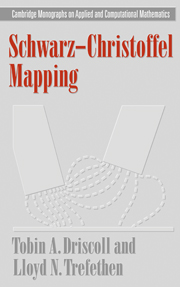5 - Applications
Published online by Cambridge University Press: 20 August 2009
Summary
Conformal mapping in general, and Schwarz–Christoffel mapping in particular, are fascinating and beautiful subjects in their own rights. Nevertheless, the history of conformal mapping is driven largely by applications, so it is appropriate to consider when and how SC mapping can be used in practical problems.
It is not our intent in this final chapter to recount every instance in which Schwarz–Christoffel mapping has been brought to bear. Rather, after a brief look at a few areas full of such examples, we describe some situations in which SC ideas can be applied in ways that are computational and perhaps not transparent. The most famous application of conformal mapping is to Laplace's equation, and we devote three sections to it. Beyond this it is clear that Schwarz–Christoffel mapping has a small but important niche in applied mathematics and science.
In applications it is common to pose a physical problem in the z-plane, which maps to a canonical region in the w-plane. This convention runs counter to our discussion in the earlier chapters, in which w was the plane of the polygon. In the following sections we attempt to be consistent with established applications literature where appropriate.
Why use Schwarz–Christoffel maps?
Schwarz–Christoffel mapping is an incomparably effective tool for a very specific sort of problem. The most natural and satisfying application is the solution of Laplace's equation in the plane with piecewise constant (and in the case of derivative conditions, homogeneous) boundary conditions.
- Type
- Chapter
- Information
- Schwarz-Christoffel Mapping , pp. 75 - 114Publisher: Cambridge University PressPrint publication year: 2002



